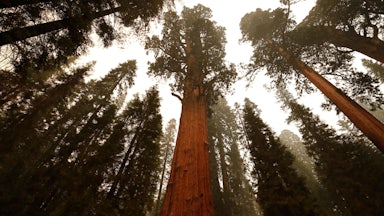A coal baron from West Virginia is blocking world-saving climate legislation that most congressional Democrats support. President Biden will head to the United Nations 2021 Climate Change Conference, or COP26, in Glasgow without a passed and signed climate deal to boast about. The United States is closer than it’s ever been to enacting serious climate change policy—the latest draft of the spending bill includes $555 billion for climate priorities. But the Clean Energy Payment Program, which was the most direct emissions-reducing policy, has been removed. And given that studies suggest $1 trillion will be needed annually to meet Paris Agreement targets, near-progress feels more like impending tragedy.
It’s an urgent moment for the climate movement. Some activists have been on hunger strike for more than a week in Washington, D.C., to demand the White House and Congress work together to pass climate provisions in the budget reconciliation plan. Others blocked traffic in Manhattan this week. Even the sober policy nerds at Vox recently interviewed an activist who wrote a book called How to Blow Up a Pipeline. Their headline? “The Case for a More Radical Climate Movement.”
Are these the right tactics? What is to be done? Anything that might help seems justified: Scientists don’t think we have much time to avoid the worst-case scenarios of mass death and irrevocable planetary damage. Yet even as we stare into a worrisome future, there’s much to learn from social movements of the recent past.
History’s first lesson? Don’t give up. As Angela Davis has pointed out, imagine being an abolitionist in 1850, the year of the Fugitive Slave Act, which mobilized the entire federal and state apparatus to capture enslaved people attempting to escape. Anti-slavery activists faced this staggering political defeat that year, yet most of them would then live to see the passage of the Thirteenth Amendment, abolishing slavery in the United States, in 1865. Similarly, said Jeanne Theoharis, a Brooklyn College professor and author of The Rebellious Life of Mrs. Rosa Parks, in the 1950s, when Rosa Parks was actively organizing, there was “no sign that she was going to see change in her lifetime.” In 1955, just months before Parks famously refused to give up her seat on a Montgomery bus, the men responsible for the death of 14-year-old Emmett Till, a child brutally murdered for supposedly flirting with a white woman, were acquitted. Parks and others worked for years to challenge the unjust conviction of Jeremiah Reeves, a Black teenager sentenced to death for the alleged rape of a white woman (he said the relationship was consensual), but Reeves was executed in 1957. Years later, Parks said of that time, “Sometimes it was very difficult to keep going when all of our work seemed to be in vain.” She could not have anticipated that her own organizing would, within the decade, help end Jim Crow and pass the Voting Rights and Fair Housing Acts. “This moment looks bleak,” said Theoharis, “but we could be on the cusp of change.”
Some will worry about the political optics of tactics like blocking traffic or blowing up pipelines, but such specifics may be beside the point. Theoharis, also the author of A More Beautiful and Terrible History: The Uses and Misuses of Civil Rights History, notes that some myths about the civil rights movement muddle our understanding of that time, in turn warping our analysis of contemporary activism. One of these myths, she says, is “the idea that there’s a right way” to protest. In recent years, centrists and conservatives have often held up the nonviolence of Rosa Parks or Martin Luther King Jr. as the “correct” persuasive strategy, in contrast to #BlackLivesMatter protesters, who have sometimes been criticized for confrontations with the police. Yet that elides the more complex history of the civil rights movement. A related myth, Theoharis told me, is that “if you shine a light on injustice in the United States it will be remedied, and that’s just not true.” These narratives, Theoharis explained, “distort how change happens and why it happens.”
The grade-school understanding of history mistakenly elevates discrete tactics and flash points. The history of a successful movement is messier—and perhaps more boring and repetitive—than common narrative suggests. “We don’t tell it as a story of perseverance,” said Theoharis, and we should. Parks didn’t succeed because of her quiet dignity in refusing to get off the bus that one day in 1955 but because Claudette Colwin and many other Black Montgomery activists had protested before her, and because Parks herself had been organizing for years.
Change comes because people keep trying. The idea that a sign of insanity is doing the same thing over and over, Theoharis laughed, is a “stupid cliché.” In fact, the history of organizing shows that what works is “having the fortitude to keep doing it.” It wasn’t that Rosa Parks just happened to engage in the right protest on that one day. “Parks’s genius,” Theoharis emphasized, was “her ability to act, and act again.”
The history of South Africa’s fight against apartheid in the 1980s is also relevant to our moment. What brought down that system, said Sean Jacobs, a scholar of South African politics who teaches at the New School, was coalition-building and solidarity. The South African anti-apartheid movement drew on the language, tradition, and lessons of that country’s radical history. In this period, Jacobs, who grew up in South Africa and came of age in the 1980s, told me, unionism evolved beyond the narrow concerns of the shop floor into a labor movement that could make connections between apartheid and the conditions of workers. These activists didn’t always focus on big ideas like “white supremacy”; rather, they linked ending apartheid to what Jacobs calls “regular things for regular people,” like housing and clean water.
While the ruling white elites had effectively used race and racism to divide people in the 1970s, anti-apartheid campaigners and unionists in the 1980s drew on a radical left-wing language of class struggle, for example, going back to the South African Congress Alliance’s Freedom Charter of 1955, which not only demanded equal rights for Black South Africans but also went bigger, envisioning a far more democratic and egalitarian society, one in which “South Africa belongs to all who live in it, black and white,” “The People Shall Govern,” “The People Shall Share in the Country’s Wealth!” and “The Land Shall Be Shared By Those Who Work It!”—to quote a few principles from that document.
“They focused on the things that bound people together,” Jacobs, founding editor of politics and culture website Africa Is a Country, observed. Some moderate Democrats and Republicans bristle when climate measures are tied to so many big-ticket social provisions, as they are in the current budget reconciliation package in Congress, or in the Green New Deal, but this recent South African history shows how powerful it is to frame demands for transformation in a context of a broader vision of shared prosperity and well-being.
Speaking with these scholars, I realized that the successful activists of the past had something in common: They studied—and learned from—history. Climate change, both in its possible solutions and in its dystopian worst-case scenarios, still feels futuristic, so it’s almost counterintuitive for the climate movement to look backward. But the past can help us move forward.










